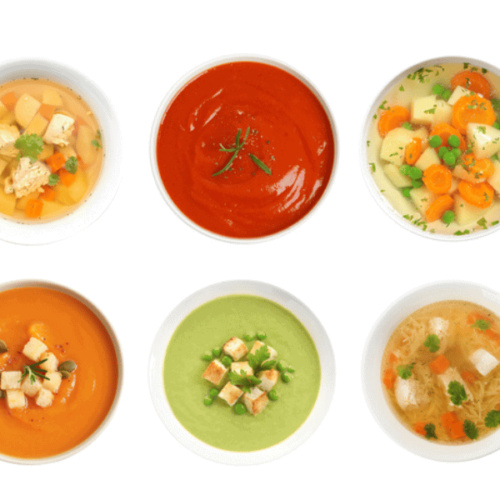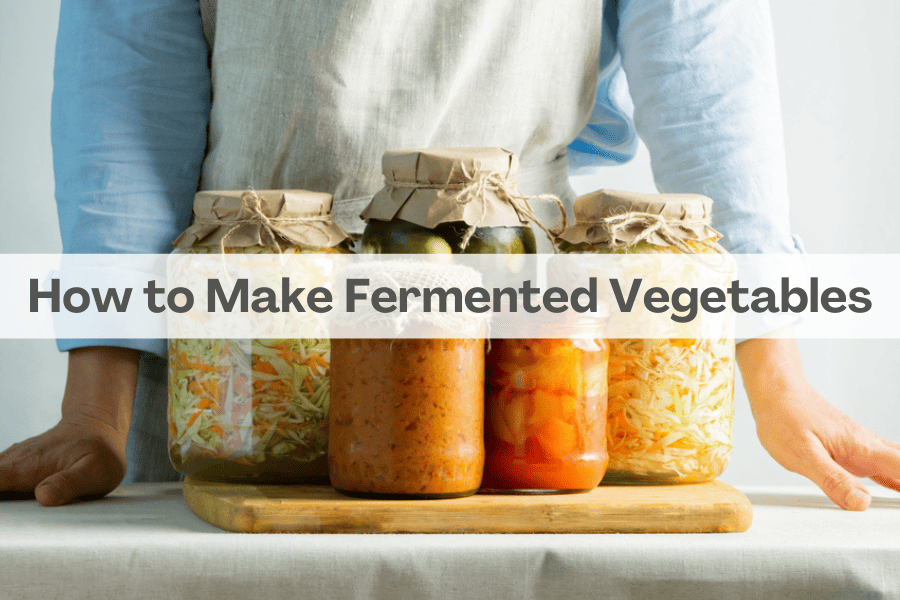
Learning how to make fermented vegetables at home is something that I have wanted to do for a long time, but never knew where to begin. I’ve always loved sauerkraut and kimchi, but never imagined that I could easily make tasty fermented veggies at home.
After experimenting with different vegetables and letting a batch or two go bad (hey, it’s a learning process!), I’ve gotten the hang of this fermentation thing. Now my kitchen counter boasts several crocks bubbling away with creations like beet kvass and ginger carrots. And let me tell you, home-fermented vegetables are a total game changer from what you get at the store!
In this beginner’s guide, I’ll walk you through the ins and outs of lactic acid fermentation so you can start cultivating your own healthy, tangy veggies. I’ll also share tips to avoid common mistakes I made as a newbie fermenter. From the best vegetables to use to troubleshooting weird colors or textures, consider this your easy, homemade sauerkraut starter kit!
Let’s dive in.
This post is all about “How to Make Fermented Vegetables at Home”.
Key Takeaways
- Fermented vegetables are preserved through lactic acid fermentation where beneficial bacteria turn sugars into lactic acid, enhancing the nutritional value and taste while promoting health benefits such as improved digestion and immune support.
- For successful fermentation, use fresh, pesticide-free vegetables, non-iodized salt, starter cultures, and proper equipment like sterilized jars, fermentation weights, and airlock lids to create an anaerobic environment.
- Monitor the fermentation process for signs of activity, store fermented vegetables in a cool place, and address common issues like mold, sliminess, or discoloration by maintaining submerged vegetables at proper temperature, and using the correct containers.
Why Make Fermented Vegetables?
Fermenting vegetables at home may seem like an overly complicated process, but it offers some major perks. For one, the fermentation process preserves fresh vegetables for months without having to freeze, can, or pickle them in vinegar. The lactic acid created through fermentation acts as a natural protector against degradation. This gives you access to nutrient-dense veggies year-round.
Beyond preservation, fermentation also enhances the nutritional quality of vegetables. Compounds like vitamins, minerals, and antioxidants become more bioavailable and easier for our bodies to absorb. And the healthy bacteria that thrive during fermentation can improve digestion, strengthen immunity, and even boost mood.
Last but not least, let’s not overlook flavor! Fermented vegetables deliver a bright, tangy flavor you won’t find with raw or cooked veggies. The aroma and taste depends on the vegetables used, spices added, and length of fermentation. But foodies agree properly fermented veggies make for delicious sides, condiments, and toppings. Whether added to salads, sandwiches, eggs or grain bowls, they liven up any meal.
So by fermenting your own vegetables at home, you can preserve the fresh summer bounty for winter, boost nutrition, and explore exciting new flavors. That’s reason enough for me to get fermenting!
Health Benefits of Fermented Vegetables
Science continues to uncover ways that fermented vegetables boost our overall wellness. First, they contain probiotics – the healthy bacteria that line our digestive tracts. Consuming fermented veggies introduces more of these microorganisms into our gut microbiome. A balanced microbiome is essential for digestion, nutrient absorption, immunity, and beyond.
Some other benefits of fermented vegetables include:
- Increased nutrient absorption
- Improved digestion
- Boosted immune system
- Enhanced flavor and texture
So why not give it a try and start fermenting your own vegetables today?
Equipment Needed to Make Fermented Vegetables
While the basic ingredients for fermented vegetables are simply fresh produce and salt, having the right equipment helps ensure success. This equipment keeps vegetables submerged, oxygen out, and the ideal conditions for lactic acid bacteria to thrive. Here’s an overview of fermentation gear for beginners:
-
Jars & Crocks: A basic mason jar or pickling jar works great for smaller batches of ferments. For larger volumes, use a stoneware crock or food-grade plastic bucket, 1-2 gallons in size. Make sure containers are thoroughly cleaned.
-
Lids: You’ll need an airlock lid, mesh lid, or loose lid lined with a clean cloth to cover jars/crocks. This allows gases to escape while keeping air out.
-
Weights: Glass jars or ceramic crock weights are ideal to keep vegetables weighed down below the liquid brine surfaces. For plastic buckets, use a plate topped with a sealed water-filled bag.
-
Temperature & Humidity Tools: A thermometer tracks ferment temperature, while a hydrometer measures brine salinity. Getting these dialed in prevents unwelcome microbes.
Other handy items include mesh strainers for pressing brine from vegetables, silicone airlock lids to burp containers, and airtight containers for finished products.
How to Make Fermented Vegetables at Home
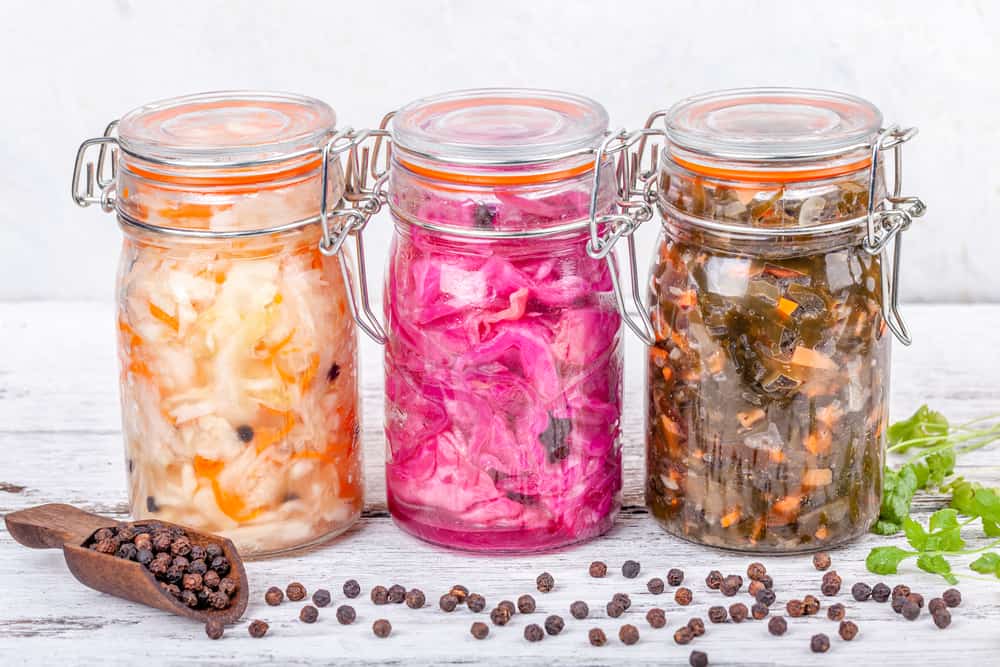
1. Select Your Ingredients (Vegetables, Salt, Starter)
The journey to making fermented vegetables begins with selecting the right vegetables and ingredients for your homemade fermented vegetables. Here are some tips to help you choose the best ones:
- Choose in-season, freshly harvested vegetables for enhanced taste and crunchiness.
- Opt for vegetables grown without pesticides and herbicides to reduce contaminants and increase beneficial bacteria.
- Consider using a variety of vegetables to add different flavors and textures to your ferment.
2. Prepare Your Vegetables for Fermentation
Start by gathering your vegetables, spices, and equiptment. Chop, grate or shred vegetables into uniform sizes to ferment evenly. Weigh or lightly pack vegetables into your fermenting vessel, leaving 2 inches of headspace at the top. Create a brine by dissolving 3-4 tablespoons non-iodized salt into a quart of non-chlorinated, unfiltered water. Pour the brine over the vegetables to fully submerge.
3. Weigh Down Vegetables
It’s critical to keep vegetables completely covered by brine throughout fermentation. Use ceramic weights, lidded containers or a resealable bag filled with extra brine on top to keep them weighed down. This prevents mold growth and allows for evenly distributed fermentation.
4. Monitor and Test Fermentation
Over the next days and weeks, monitor brine cloudiness, bubbles and white film on the surface as signs of active fermentation. Taste vegetables periodically using a clean utensil. When desired sourness is reached, transfer vegetables with a slotted spoon into storage containers, topping with brine.
5. Store Final Product
Bottled properly, fermented vegetables stay good for at least 6-8 months. Refrigerate for up to a year, replenishing evaporated brine as needed. For extended shelf life, process pint jars in a water bath canner. Always discard any vegetables with obvious mold or strange colors. Enjoy your homemade ferments!
Cleaning and Cutting Techniques
Before you start fermenting, ensuring your vegetables are clean and free from dirt and potential contaminants is crucial. Use a vegetable brush to scrub the vegetables under running water for a thorough clean. Depending on the type of vegetable, consider parboiling, like in the case of green beans, or rinsing, as with cucumbers.
The cutting techniques will vary depending on the type of vegetable and the desired texture. For instance, cucumbers can be sliced into rounds, spears, or left whole for fermentation. For dry salting techniques, vegetables are typically cut finely to help them release water and create their own brine.
Creating the Perfect Brine
Creating the perfect brine is more than just mixing salt and water. A typical recipe for most hard vegetables is to combine 2 tablespoons of kosher salt with 1 quart of water, fully dissolving the salt to ensure a homogeneous solution. Using distilled or purified water free from contaminants is crucial to avoid killing beneficial bacteria, while non-iodized salt like kosher salt aids in inhibiting the growth of harmful bacteria.
For a desirable texture in your fermented vegetables, consider adding food-grade calcium chloride to the brine. Finally, ensuring an adequate salt concentration in the brine helps maintain an anaerobic environment necessary for fermentation and prevents mold and other unwanted microbial growth.
Essential Equipment for Fermenting Vegetables
Having the right equipment at hand can make the fermenting process much easier and efficient. The essentials include:
- Sterilized jars
- The vegetables
- Muslin or baking parchment for covering jars
- Airlock lids or fermentation weights to maintain an anaerobic environment.
Up next, we’ll learn how to choose the right container and the significance of using fermentation weights and airlock lids.
Choosing the Right Container
The container you choose to ferment your vegetables in can significantly impact the outcome of your fermentation. Glass containers are preferred as they don’t scratch easily and don’t contain chemicals like BPA.
Ceramic fermentation crocks are common for making large batches of fermented vegetables, ranging from 5-20 liters in size. If you opt for porcelain, make sure it is food-grade to ensure safe fermentation.
Using Fermentation Weights and Airlock Lids
Ensuring your vegetables stay submerged under the brine is critical for maintaining the necessary anaerobic environment for lactic acid fermentation. To achieve this, fermentation weights are used. These can be glass or ceramic weights, small glass jars, or even food-safe plastic bags filled with water.
To let out the gases produced during fermentation without letting outside air in, airlock lids are used. These can be water-sealed, silicone one-way valves, or low-profile waterless valves. If you’re using regular lids, remember to ‘burp’ them daily to release the gases and prevent potential explosion due to pressure build-up.
The Fermentation Process: Step-by-Step Guide
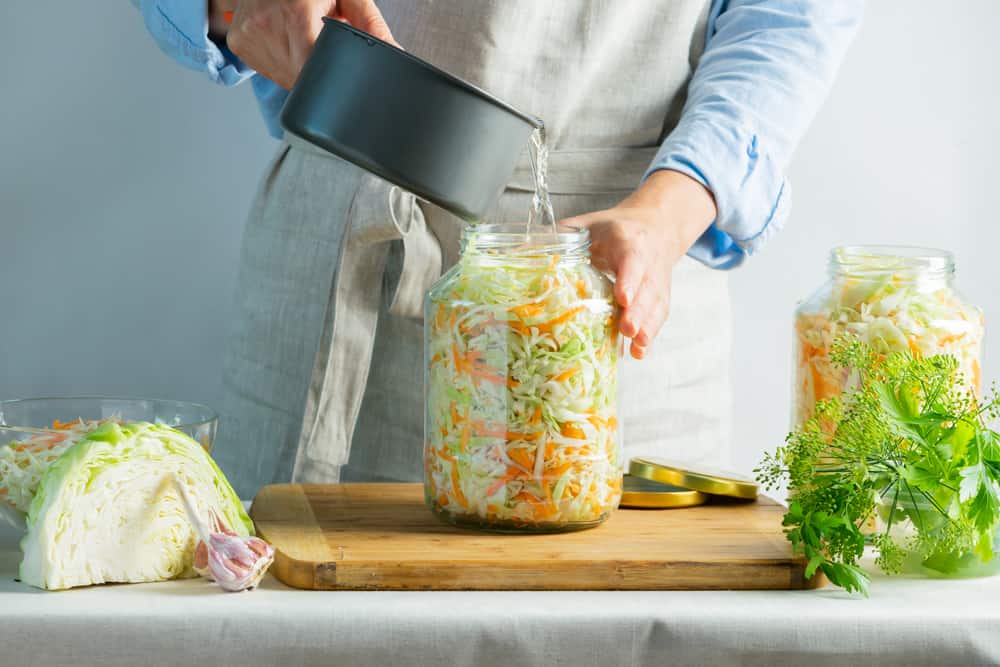
Now that you are equipped with the knowledge and necessary tools, it’s time to start the fermentation process. We will guide you through combining the ingredients, packing the jars, and monitoring the fermentation process. Remember, fermented vegetables are ideal for beginners due to the minimal equipment and simple processes involved, and the relatively quick time-frame until they are ready to eat.
Next, we will learn the best ways to mix the ingredients, pack the jars, and keep an eye on the fermentation process.
Combining Ingredients and Packing Jars
After cleaning and chopping your vegetables, salt them and either squeeze or pound them to draw out their juices. Once done, tightly pack them into sterilized containers where they are completely submerged in the juices for fermentation. Ensuring the jars are sterilized is crucial to prevent contamination and ensure a successful ferment. This process of pickling vegetables helps preserve them for an extended period.
For each batch, it’s recommended to use a new sachet of starter culture to ensure a proper balance of bacteria. If you prefer a crispier texture in your fermented vegetables, consider adding grape leaves, horseradish leaves, or black tea leaves to the brine as they contain tannins, which help achieve the desired crispness.
Monitoring and Adjusting Fermentation
Monitoring your jars for signs of activity, like bubble formation, is an important part of the fermentation process, which can take between 8-10 days. Successful fermentation is often indicated by the presence of small bubbles and sometimes color changes, like garlic turning blue or green, which is a harmless reaction that doesn’t affect taste or safety. If the vegetables ferment rapidly in warm temperatures, they should be moved to a fridge after 2 days to prevent them from getting too mushy.
To achieve consistent and thorough fermentation, using a starter culture is recommended as it promotes a quicker and more complete ferment.
Fermentation Process Explained
Fermentation, specifically lactic acid fermentation, is an intriguing anaerobic process where the real heroes are the lactic acid bacteria. These microscopic organisms feast on the natural sugars found in vegetables, converting them into lactic acid. This production of lactic acid not only gives fermented vegetables their distinct tangy flavor but also acts as a natural method of preservation.
As the lactic acid accumulates, it lowers the pH of the fermenting vegetables, creating an environment inhospitable to unwanted microbes. This simple yet effective mechanism keeps your ferment safe from the invasion of harmful bacteria.
In addition, these beneficial bacteria enhance the nutritional quality of your vegetables by synthesizing vitamins and increasing the availability of nutrients, making every bite you take a nutritional powerhouse.
Simply put, vegetable fermentation relies on a group of bacteria known as lactic acid bacteria (LAB). These bacteria occur naturally on the skins of fresh, living plants. When vegetables are submerged in a salty brine solution, it creates an anaerobic environment, meaning no oxygen is present. Beneficial LAB kick into high gear in this oxygen-free ecosystem by consuming sugars and starch in vegetables and converting them into lactic acid.
The lactic acid accumulates with time and causes pH levels to drop. This increase in acidity essentially pickles the vegetables, enhances flavors, and preserves the food while “starving out” dangerous bacteria that could cause rotting or food poisoning. A proper ferment maintains an ideal temperature and steady salinity level to encourage lactic acid bacteria to thrive among yeasts and other microflora.
To achieve successful, safe fermentation at home, the major goals are:
- Maintain anaerobic conditions
- Lower pH levels via lactic acid
- Prevent “bad” microbes through proper salt concentration, acidity increase and temperature control
It can take anywhere from a week to several months for vegetables to fully ferment depending on environmental conditions and personal taste preferences. Paying attention to signs of fermentation activity is key.
The Science Behind Fermentation
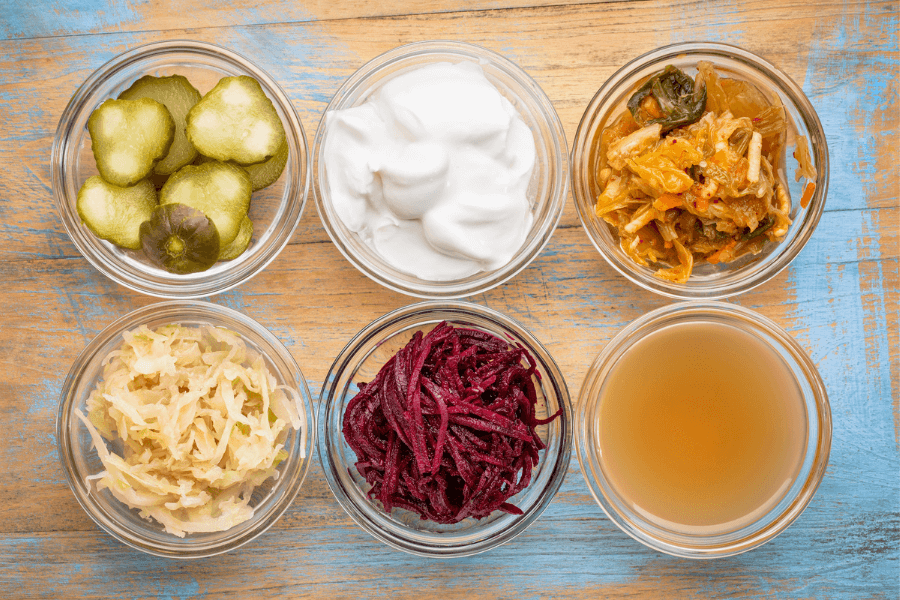
Health Benefits of Fermented Foods
The amazing health benefits of fermented vegetables stem from the live probiotics they contain. These beneficial bacteria promote a healthy balance of microbes in your gut, which can strengthen your immune system. The lactic acid and butyric acid produced during fermentation serve as energy sources for the gut lining and gut tissue, contributing positively to your gut health.
Do fermented vegetables provide health benefits? Absolutely! Eating fermented foods, such as fermented vegetables, offers several advantages, including:
- Dietary fibers that feed your gut microbiome, aiding digestion
- Increased availability of essential B vitamins and vitamin C, as the lactic acid bacteria involved in fermentation can synthesize these nutrients
- Production of antioxidants to protect your health, which is another benefit of consuming fermented food.
The regular inclusion of fermented vegetables in your diet may contribute to a decrease in the risk of developing chronic conditions like:
- Inflammatory bowel disease
- Cardiovascular disease
- Cancer
- Diabetes
Storing and Enjoying Your Fermented Vegetables
After the fermentation process, your homemade fermented vegetables need to be stored properly to maintain their quality and prolong their shelf life. The ideal storage place is in cold storage, like a refrigerator or cold cellar, which helps slow down but does not stop the fermentation organisms.
Once familiar with the fermentation process, one can explore various fermented vegetable recipes for home preparation. Let’s now understand some cold storage tips and explore various serving suggestions and recipe ideas.
Cold Storage Tips
Cold storage is critical in maintaining the quality of your fermented vegetables. When properly sealed and stored, fermented vegetables can have a shelf life ranging from four to eighteen months. To halt the fermentation process, replace the airlock lid with a regular Mason jar lid and place the jar in the refrigerator.
Replacing any airlock lids with regular lids is crucial when using cold storage to ensure the fermented vegetables are properly sealed.
Serving Suggestions and Recipe Ideas
Your homemade fermented vegetables can be a key ingredient in classic recipes or can bring a new twist to table favorites, including pickled foods. Some ideas for using fermented vegetables include:
- Caraway Sauerkraut
- Pepper Mash
- Hot Pink Jalapeño Garlic Kraut
- Fermented Mustard
- Fermented Hot Sauce
- Cucumber Kimchi
- Fermented Beets
- Fermented Radish
- Home-cured Olives
The possibilities are endless! Get creative and explore different ways to incorporate fermented vegetables into your dishes, or even learn how to ferment vegetables yourself.
Fermented vegetables like kimchi can also be used to zest up meals such as kimchi fried rice, kimchi sesame udon noodles, and kimchi cheese toasties. The versatility of fermented veggies in culinary applications is truly remarkable.
Troubleshooting Common Fermentation Issues
While fermenting vegetables at home can be a rewarding experience, it’s not uncommon to encounter a few hiccups along the way. Some common issues include:
- Mold
- Off-odors
- Slimy texture
- Discoloration
But don’t worry, most of these can be easily addressed with a little knowledge and some quick actions.
Next, we’ll learn some strategies on how to prevent mold and off-odors and address issues like slimy texture or discoloration.
Preventing Mold and Off-Odors
Preventing mold and off-odors starts with using the right containers for fermentation. Non-plastic containers like glass or ceramic are preferred as they don’t scratch or harbor bacteria in scratches and don’t contain chemicals that may contribute to contamination and mold growth.
A white, fairly flat film on the surface of your ferment is commonly kahm yeast, which is harmless and should not be confused with mold, which appears as green, black, red, or pink fuzzy spots. If mold is present, it’s recommended to:
- Scrape off the moldy layer
- Check the smell and taste of the vegetables beneath
- If there is a bad odor or taste after removing the mold, discard the batch.
Dealing with Slimy Texture or Discoloration
A slimy texture in fermented vegetables can be due to incorrect fermentation temperatures or contamination from an external source of bacteria. To prevent a slimy texture, make sure your vegetables are kept submerged in brine and the fermentation occurs at a consistent, suitable temperature.
Dramatic color changes, such as blackened carrots or unusually colored cauliflower, often signal spoilage and typically warrant discarding the batch unless there’s an obvious non-spoilage reason for the color change. While vegetables may naturally soften during fermentation, extreme softness or mushiness beyond what is typical for the type of vegetable may indicate an issue with the fermentation process.
Summary
Fermenting vegetables at home is an exciting journey that allows you to explore the vast world of flavors while reaping numerous health benefits. From choosing the right vegetables and ingredients, preparing them for fermentation, to storing and enjoying the fruits of your labor, the process is rewarding and worthwhile. Remember, if you encounter any fermentation issues, most can be easily addressed with a little knowledge and quick actions. So why not start fermenting your own vegetables today and enjoy the unique, tangy flavors it brings to your table?
Frequently Asked Questions
How do you ferment your own vegetables?
To ferment your own vegetables, start by sterilizing your jar, preparing the vegetables, making a brine, adding the vegetables to the jar, pouring over the brine, leaving it to ferment at room temperature, and then placing it in the fridge to finish fermentation.
Do you need vinegar to ferment vegetables?
Yes, you can use vinegar to help prevent unwanted bacteria and enhance the flavor of fermented vegetables, especially in warmer temperatures. Apple cider vinegar, wine vinegar, or rice vinegar are suitable options.
What equipment do you need to ferment vegetables?
To ferment vegetables at home, invest in a scale, canning jars, air locks, fermentation weights, a fermentation crock, pH strips and a meter, and glass bottles for the best results.
What vegetables can I ferment?
You can ferment almost any vegetable, but popular choices include cabbage, cucumbers, beans, carrots, wild garlic, and spring onions. So, feel free to experiment with your favorite veggies!
What kind of salt should I use for fermentation?
You should use natural, additive-free salts like kosher salt, unrefined sea salts, or pure pink Himalayan salt for fermentation. These types of salt are best for preserving the flavor and texture of fermented foods.

